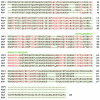Characterization of NopP, a type III secreted effector of Rhizobium sp. strain NGR234
- PMID: 15231809
- PMCID: PMC438593
- DOI: 10.1128/JB.186.14.4774-4780.2004
Characterization of NopP, a type III secreted effector of Rhizobium sp. strain NGR234
Abstract
The type three secretion system (TTSS) encoded by pNGR234a, the symbiotic plasmid of Rhizobium sp. strain NGR234, is responsible for the flavonoid- and NodD1-dependent secretion of nodulation outer proteins (Nops). Abolition of secretion of all or specific Nops significantly alters the nodulation ability of NGR234 on many of its hosts. In the closely related strain Rhizobium fredii USDA257, inactivation of the TTSS modifies the host range of the mutant so that it includes the improved Glycine max variety McCall. To assess the impact of individual TTSS-secreted proteins on symbioses with legumes, various attempts were made to identify nop genes. Amino-terminal sequencing of peptides purified from gels was used to characterize NopA, NopL, and NopX, but it failed to identify SR3, a TTSS-dependent product of USDA257. By using phage display and antibodies that recognize SR3, the corresponding protein of NGR234 was identified as NopP. NopP, like NopL, is an effector secreted by the TTSS of NGR234, and depending on the legume host, it may have a deleterious or beneficial effect on nodulation or it may have little effect.
Copyright 2004 American Society for Microbiology
Figures



References
-
- Annapurna, K., and H. B. Krishnan. 2003. Molecular aspects of soybean cultivar-specific nodulation by Sinorhizobium fredii USDA257. Indian J. Exp. Biol. 41:1114-1123. - PubMed
-
- Ausmees, N., K. Jacobsson, and M. Lindberg. 2001. A unipolarly located, cell-surface-associated agglutinin, RapA, belongs to a family of Rhizobium-adhering proteins (Rap) in Rhizobium leguminosarum bv. trifolii. Microbiology 147:549-559. - PubMed
-
- Ausubel, F. M., R. Brent, R. E. Kingston, D. D. Moore, J. G. Seidman, and J. A. Smith. 1991. Current protocols in molecular biology. John Wiley & Sons, New York, N.Y.
-
- Bartsev, A. V., N. M. Boukli, W. J. Deakin, C. Staehelin, and W. J. Broughton. 2003. Purification and phosphorylation of the effector protein NopL from Rhizobium sp. NGR234. FEBS Lett. 554:271-274. - PubMed
Publication types
MeSH terms
Substances
LinkOut - more resources
Full Text Sources
Other Literature Sources

